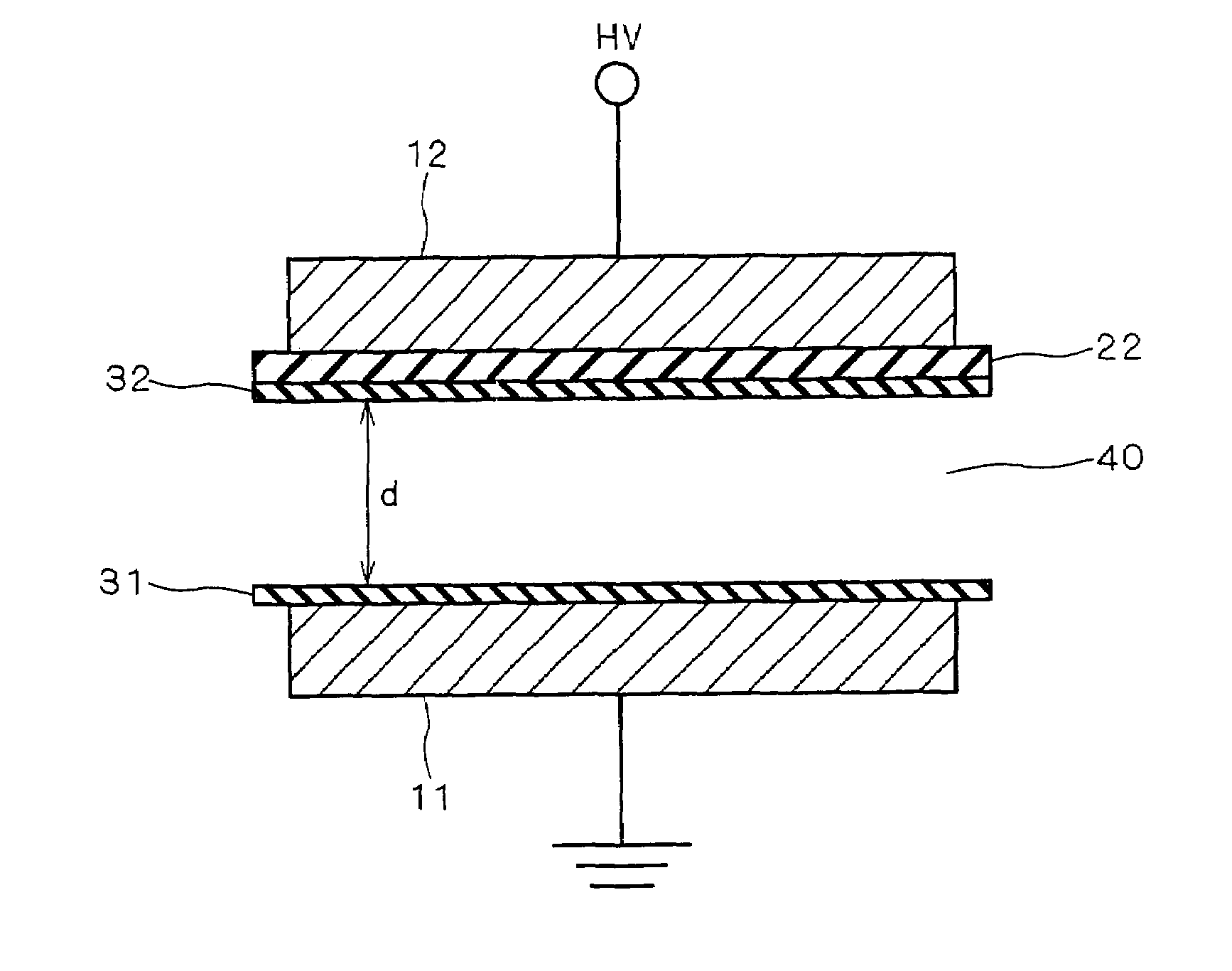Ozone generating apparatus
a technology of generating apparatus and ozone, which is applied in the direction of ozone preparation, oxygen/ozone/oxide/hydroxide, electrical discharge ozone preparation, etc., can solve the problems of performance change, difficult to maintain ozone generation efficiency, and inability to achieve high ozone generation efficiency, etc., to achieve high degree of efficiency
- Summary
- Abstract
- Description
- Claims
- Application Information
AI Technical Summary
Benefits of technology
Problems solved by technology
Method used
Image
Examples
first preferred embodiment
[0028]FIGS. 1 and 2 are views for illustrating an ozone generating apparatus according to a first preferred embodiment of the present invention. More specifically, FIG. 1 is a sectional view showing a construction of an electrode section according to the first preferred embodiment, and FIG. 2 is a sectional view showing a construction of a conventional typical parallel plate electrode section for use in a silent discharge ozone generating apparatus.
[0029]As illustrated in FIG. 2, the conventional typical parallel plate electrode section for use in the silent discharge ozone generating apparatus includes a pair of electrodes, i.e. an earthed electrode (metal electrode) 11 and a high-voltage electrode (metal electrode) 12, and dielectrics 21 and 22. The pair of earthed and high-voltage electrodes 11 and 12 are provided so that the dielectrics 21 and 22 lie between the pair of electrodes 11 and 12 and in contact with the pair of electrodes 11 and 12, respectively, and so that a certain...
second preferred embodiment
[0062]FIG. 5 is a view for illustrating the ozone generating apparatus according to a second preferred embodiment of the present invention and, more specifically, is a sectional view showing the construction of the electrode section according to the second preferred embodiment.
[0063]Effects similar to those of the first preferred embodiment are produced in the ozone generating apparatus including the electrode section with the construction as shown in FIG. 5 and having a discharge gap length d of 0.1 mm.
[0064]The construction of the electrode section shown in FIG. 5 differs from that of the first preferred embodiment in that the dielectric 21 is provided between the earthed electrode 11 and the low-resistance element 31 in the structure of the first preferred embodiment shown in FIG. 1. The remaining construction of the second preferred embodiment is identical with that of the first preferred embodiment. Alumina (having a volume resistivity of not less than 109 Ω·cm, a dielectric st...
third preferred embodiment
[0068]FIG. 6 is a view for illustrating the ozone generating apparatus according to a third preferred embodiment of the present invention and, more specifically, is a sectional view showing the construction of the electrode section according to the third preferred embodiment.
[0069]Effects similar to those of the first preferred embodiment are produced in the ozone generating apparatus including the electrode section with the construction as shown in FIG. 6 and having a discharge gap length d of 0.1 mm.
[0070]The construction of the electrode section shown in FIG. 6 differs from that of the first preferred embodiment in that the earthed electrode 11 is not provided with the low-resistance element 31, but is in direct contact with the discharge in the structure of the first preferred embodiment shown in FIG. 1. The remaining construction of the third preferred embodiment is identical with that of the first preferred embodiment. Alumina (having a volume resistivity of not less than 109 ...
PUM
| Property | Measurement | Unit |
|---|---|---|
| discharge gap length | aaaaa | aaaaa |
| resistance | aaaaa | aaaaa |
| resistance | aaaaa | aaaaa |
Abstract
Description
Claims
Application Information
 Login to View More
Login to View More - R&D
- Intellectual Property
- Life Sciences
- Materials
- Tech Scout
- Unparalleled Data Quality
- Higher Quality Content
- 60% Fewer Hallucinations
Browse by: Latest US Patents, China's latest patents, Technical Efficacy Thesaurus, Application Domain, Technology Topic, Popular Technical Reports.
© 2025 PatSnap. All rights reserved.Legal|Privacy policy|Modern Slavery Act Transparency Statement|Sitemap|About US| Contact US: help@patsnap.com



